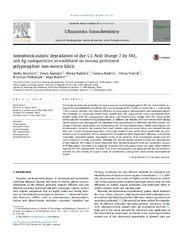Приказ основних података о документу
Sonophotocatalytic degradation of dye CI Acid Orange 7 by TiO2 and Ag nanoparticles immobilized on corona pretreated polypropylene non-woven fabric
| dc.creator | Marković, Darka | |
| dc.creator | Šaponjić, Zoran | |
| dc.creator | Radoičić, Marija B. | |
| dc.creator | Radetić, Tamara | |
| dc.creator | Vodnik, Vesna | |
| dc.creator | Potkonjak, Branislav | |
| dc.creator | Radetić, Maja | |
| dc.date.accessioned | 2021-03-10T12:49:04Z | |
| dc.date.available | 2021-03-10T12:49:04Z | |
| dc.date.issued | 2015 | |
| dc.identifier.issn | 1350-4177 | |
| dc.identifier.uri | http://TechnoRep.tmf.bg.ac.rs/handle/123456789/3050 | |
| dc.description.abstract | This study discusses the possibility of using corona pre-treated polypropylene (PP) non-woven fabric as a support for immobilization of colloidal TiO2 and Ag nanoparticles in order to remove dye C.I. Acid Orange 7 from aqueous solution. Dye removal efficiency by sonocatalysis, photocatalysis and sonophotocatalysis was evaluated on corona pre-treated fabric loaded with TiO2 nanoparticles, corona pre-treated fabric double loaded with TiO2 nanoparticles and corona pre-treated fabrics loaded with TiO2 nanoparticles before and after deposition of Ag nanoparticles. In addition, the stability of PP non-woven fabric during these processes was investigated. The substrates were characterized by SEM, EDX and AAS analyses. The change of the dye concentration was evaluated by UV-VIS spectrophotometry. Unlike sonocatalysis and photocatalysis, complete dye removal from both solution and non-woven fabric was obtained already after 240-270 min of sonophotocatalysis. Corona pre-treated PP non-woven fabric loaded with Ag nanoparticles prior to deposition of TiO2 nanoparticles provided excellent degradation efficiency and superior reusability. Sonophotocatalytic degradation of dye in the presence of all investigated samples was the most prominent in acidic conditions. Although this nanocomposite system ensured fast discoloration of dye solution, TOC values of water measured after sonophotocatalysis were not satisfactory because of PP degradation. Therefore, it is suggested to include TOC evaluation in each case study where different supports for TiO2 nanoparticles are used since these nanoparticles may guarantee the dye removal from solution but the stability of support could be problematic causing even more serious environmental impact. | en |
| dc.publisher | Elsevier, Amsterdam | |
| dc.relation | info:eu-repo/grantAgreement/MESTD/Integrated and Interdisciplinary Research (IIR or III)/45020/RS// | |
| dc.relation | info:eu-repo/grantAgreement/MESTD/Basic Research (BR or ON)/172056/RS// | |
| dc.rights | openAccess | |
| dc.source | Ultrasonics Sonochemistry | |
| dc.subject | Polypropylene | en |
| dc.subject | Non-woven fabric | en |
| dc.subject | Corona discharge | en |
| dc.subject | TiO2 nanoparticles | en |
| dc.subject | Ag nanoparticles | en |
| dc.subject | Sonophotocatalysis | en |
| dc.title | Sonophotocatalytic degradation of dye CI Acid Orange 7 by TiO2 and Ag nanoparticles immobilized on corona pretreated polypropylene non-woven fabric | en |
| dc.type | article | |
| dc.rights.license | ARR | |
| dc.citation.epage | 229 | |
| dc.citation.other | 24: 221-229 | |
| dc.citation.rank | aM21 | |
| dc.citation.spage | 221 | |
| dc.citation.volume | 24 | |
| dc.identifier.doi | 10.1016/j.ultsonch.2014.11.017 | |
| dc.identifier.fulltext | http://TechnoRep.tmf.bg.ac.rs/bitstream/id/1067/3047.pdf | |
| dc.identifier.pmid | 25487219 | |
| dc.identifier.scopus | 2-s2.0-84921442588 | |
| dc.identifier.wos | 000349726500029 | |
| dc.type.version | publishedVersion |

